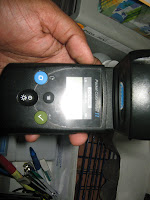Water is a basic necessity when it comes to life. The importance of monitoring water quality is as important as drinking water everyday.
In this post we will be looking into the unit controlling the water quality and how it functions.
Although the importance of this unit is high but, the importance based on staff allocation is not proven to be one. There are only two officers in-charge of this unit.
The main will be: (substitute) Mr. Izzuddin and he has his assistant. Mr. Izz is just an acting chief of the unit as the chief is on leave.
He claims most of the job workload ends on the desk it self, end of the day, if they receive any complaints of water impurity then the field work starts.
Besides that, the unit itself run a routine check before the water source is released for public use.
The sampling of water is done twice a week. The samplings are done from various part of stations which he called as “points”. They have one exactly in front of their Health office in Sik. Besides that, there are also number of them around in Sik.
The samplings are done to check on both Bio-Chemical and Microbiological aspects.
When are they done:
a) Samplings done prior to water treatment
b) Samplings done after water treatment
c) Samplings done before supply connected to public.
Now, we will look into the aspects that are monitored during the “point” checks.
a) Chloride level in water
b) pH of water
c) Conductivity of water
d) Turbidity of the water
e) Organisms in the water (mainly microbiology unit)
Above pic, from left to right: water pH, conductivity, turbidity, Chloride concentration.
The image on top shows the electronic gadgets used to evaluate different aspects of water as mentioned above.
The samples taken for microbiological assessment should reach the lab within 24 hours or else it is deemed as unfit for analysis.
There are cases reported positive of samples containing leptospirosis organism.
The source mainly from lake water. The officer claimed its mainly on the lower side closer to a canteen and not on the upper side. Rat habitation might be one of the cause. Observations are done routinely to monitor the situation.
How are samples taken:
a) Samples, as mentioned above are normally drawn from the “point”.
 This point is actually a small station with built in tap. As you can see from the image beside, its a inversed “J- shaped” tap. Its of chrome, the officer claimed.
This point is actually a small station with built in tap. As you can see from the image beside, its a inversed “J- shaped” tap. Its of chrome, the officer claimed.
b)Before sample of water are collected, water from the tap is let for a free flow in due to clear any stagnant water, then using a glass contained the water sample is taken.
c) to test for chloride, small amount of chloride particles are added to the water sample which turns into pink after a shake. Its then wiped of clean from any water drops outside the container. This is
so that the results will not contribute towards false positive.
d) using designated electronic measurement tool the concentration of chloride is then analysed.
e) same goes to other test except for the samples that will be sent for microbiological
assessment.
For samples being sent for microbiological assessment, the tap (inversed J shaped) will be heated thoroughly to kill any existing organism on the tap itself.
After which water is let for a free flow before samples drawn. Samples are labelled and sealed, within 24hours sent for analysis.
As mentioned above, samples are also taken from rivers too. The SIK health office is in-charge of 2 rivers, namely, Kuala Muda and Sik rivers respectively.
Samples are taken from all the point throughout the river. If there are contaminations, the points will help the officers to trace where it started.
Below are some photos that i took…have been uploaded for your view.
So, Ladies and Gentlemen, we all understand how important water is in our daily life, drinking is not all our responsibility is, when it comes to taking care of its purity, it is a must for all of us. This will contribute towards a better health and if we save the water…then a better future too….
-adios-
By S.Pala
Source: mbbs12sik.blogspot.com







